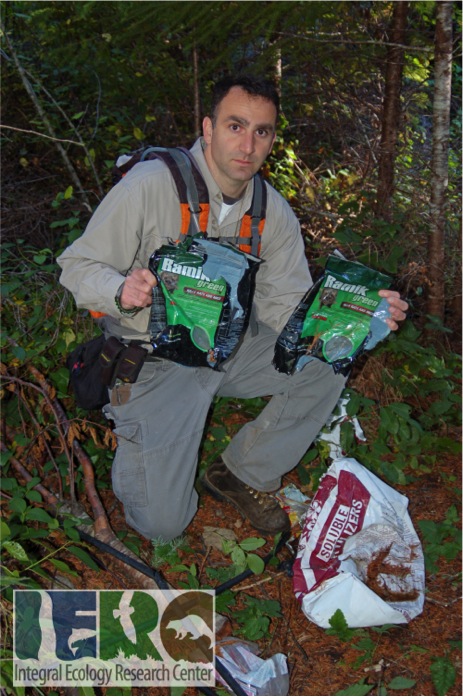Most visitors to a national forest will never stumble across an illegal marijuana plantation site hidden in remote areas where detection is unlikely. But literally hundreds of grow sites have been discovered on public forest lands in the Sierra Nevada region, and hundreds of other grow sites are acknowledged by law enforcement to almost certainly be used each year without any detection.
Most grow sites reveal months of garbage and waste that have accumulated from whoever tended the illegal pot gardens. Of far greater concern are the high levels of poison chemicals that consistently are found. Highly toxic rodenticides can be spread across many acres in an effort to prevent damage to the valuable crop.
Dr. Mourad Gabriel, executive director of Integral Ecology Research Center, is shown at right and below at grow sites where poison rodenticides were used. Law enforcement at a different site on national forest land discovered poison-soaked hot dogs on fish hooks strung across the area. The amount and kinds of poison varies from site to site, but even small amounts scattered about are sufficiently toxic to kill deer, bears, squirrels, mice, wood rats, raccoons, and the predators or scavengers that may feed on the poisoned animals. For many years, CSERC staff has attended conferences and workshops focusing on how to protect the rare Pacific fisher – a weasel-like furbearer of the Sierra Nevada that is currently only found in the southern portion of the range. Two decades ago, CSERC’s director walked up close to a fisher on the Stanislaus Forest, but in all of CSERC’s photo-detection surveys, no fishers have been successfully photographed in the Stanislaus Forest or in the northern portion of Yosemite Park. CSERC cameras have only detected fishers in the southern portion of Yosemite Park. There may be multiple reasons why the fisher is missing from some historically occupied areas and why there are low numbers surviving in the overall Sierra Nevada region. But scientific studies over recent years have identified rodenticides as one clear, significant threat to fishers where they do still exist.
For many years, CSERC staff has attended conferences and workshops focusing on how to protect the rare Pacific fisher – a weasel-like furbearer of the Sierra Nevada that is currently only found in the southern portion of the range. Two decades ago, CSERC’s director walked up close to a fisher on the Stanislaus Forest, but in all of CSERC’s photo-detection surveys, no fishers have been successfully photographed in the Stanislaus Forest or in the northern portion of Yosemite Park. CSERC cameras have only detected fishers in the southern portion of Yosemite Park. There may be multiple reasons why the fisher is missing from some historically occupied areas and why there are low numbers surviving in the overall Sierra Nevada region. But scientific studies over recent years have identified rodenticides as one clear, significant threat to fishers where they do still exist.
Public land officials acknowledge that law enforcement staffing is inadequate to locate all of the illegal grow sites on national park, national forest, and BLM lands of the region. Even where grow sites are discovered and pot is stripped by law enforcement crews, there often is no funding or trained personnel available to remove all the trash and the highly poisonous rodenticides or other toxic materials at these remote forest sites. Thus, the poisons may keep on killing.

